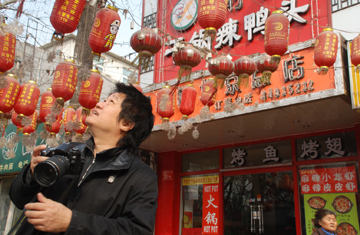
The biker bon vivantSeetoh's guides are the product of painstaking time on the road
Trust a Singaporean to declare that a city's history lies buried not in its museums or architecture but in its food. At least K.F. Seetoh makes a convincing case. Through his popular Makansutra eating guide and TV show (makan means "to eat" in Malay), he has become his city's culinary archeologist.
Shaggy-haired Seetoh says his knowledge of Singapore food culture came from his days as a photographer on the Straits Times. Part of the job entailed trawling the city on a motorbike for stories. More often, though, Seetoh would stumble into edible scoops. He recalls: "Somebody would call me up and say, 'Make a detour into this place and pick up chicken rice.' That's how I got to know most of the hawker stalls on the island."
The Makansutra guide, first published in 1998 and now in its seventh edition, was born from this street research. In the 12 years since, Seetoh has parlayed the original guide's success into a modest food-court business, a website, restaurant consultancies and television programs, where he is known for garnishing his meals with comic Singlish outbursts before revving up his motorbike to roar on to the next calorific meal.
During a morning meeting in a 1960s-era hawker center, Seetoh appears more subdued than his TV persona, apart from the witticism on his T-shirt: "Praise the Lard." Therein lies a gentle warning: the food Seetoh celebrates, from char kway teow (fried rice noodles) to the ubiquitous laksa, is delicious but not something that the weight-conscious will want to enjoy frequently. And yet Seetoh's own girth ("Who says I'm not fat, lah?") is surprisingly modest considering the hazards of his job.
Perhaps he expends a lot of energy in looking for what a meal might reveal of the city's past. "The story of food in Singapore is one of desperation," he says, describing how some now accepted constituents of popular dishes were originally added because poor migrants couldn't afford any better. One example is hemoglobin extracted from blood cockles — a species of clam that could be freely scavenged on any beach. The liquid was (and still is) used to add piquant flavor to char kway teow.
Seetoh also makes the wider point that such culinary improvisation never compromised craft, and one of his favorite eating spots illustrates this amply. It's a closet-sized stall run by a man whom Seetoh says has repeatedly declined million-dollar offers to expand his business because he wants to retain its homegrown authenticity. Every day, the stall's Hokkien mee is prepared in the same painstaking way: the noodles are seared in an egg-rinsed wok before shrimp, squid and bean sprouts are added, then they're cooked in a salty seafood stock and refried with garlic. "He's like an artist," Seetoh says.
But just as Singaporean cuisine was born in humble circumstances, so the country's current prosperity might prove its undertaker. Singapore does a creditable job in presenting a lively food culture to tourists, however the reality is that the advent of branded fast food, and the proliferation of more lucrative careers for the descendants of food-stall owners, is pushing that culture to slow extinction. "I'm clinging onto an era that I can't get enough of," Seetoh says sadly. More power to his painstaking digging.
Got an awful travel gripe? The Avenger may be able to sort it out for you.
